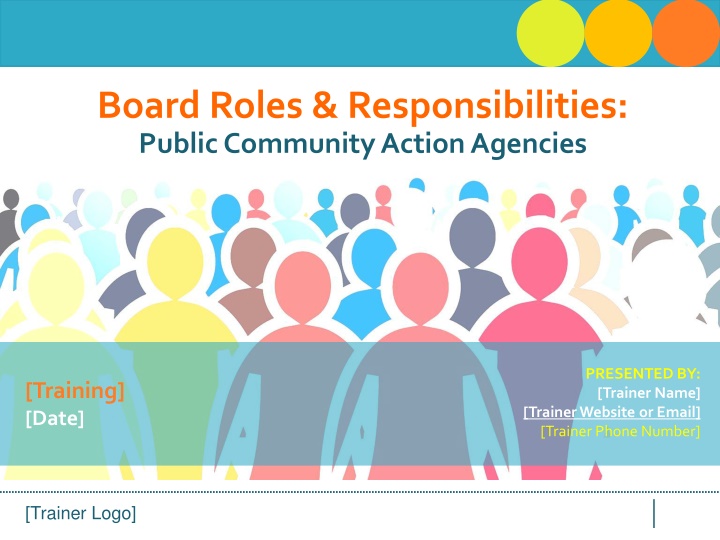
Board Roles and Responsibilities for Public Community Action Agencies
Explore the roles and responsibilities of boards in public community action agencies, presented in collaboration with CAPLAW and the Community Action Partnership. Understand the duty of care, tripartite board scenarios, and key tasks for effective board committees. Dive into real-world examples to learn about decision-making processes and implications for program outcomes.
Download Presentation

Please find below an Image/Link to download the presentation.
The content on the website is provided AS IS for your information and personal use only. It may not be sold, licensed, or shared on other websites without obtaining consent from the author. If you encounter any issues during the download, it is possible that the publisher has removed the file from their server.
You are allowed to download the files provided on this website for personal or commercial use, subject to the condition that they are used lawfully. All files are the property of their respective owners.
The content on the website is provided AS IS for your information and personal use only. It may not be sold, licensed, or shared on other websites without obtaining consent from the author.
E N D
Presentation Transcript
Board Roles & Responsibilities: Public Community Action Agencies PRESENTED BY: [Trainer Name] [Training] [Date] [Trainer Website or Email] [Trainer Phone Number] [Trainer Logo]
This training material was created in collaboration with Community Action Program Legal Services, Inc. (CAPLAW) and the Community Action Partnership (Partnership). The publication was created by National Association of Community Action Agencies - Community Action Partnership in the performance of the U.S. Department of Human Services, Administration for Children and Families, Office of Community Services Grant Number 90ET0465. Any opinion, findings, and conclusions, or recommendations expressed in this material are those of the authors and do not necessarily reflect the views of the U.S. Department of Health and Human Services, Administration for Children and Families. 2
Duty of Care Generally, not a requirement but serves as an informative guide Check local laws Diligent Acting with the care of a prudent person in similar circumstances Asking hard questions Reading materials Deliberating the decision 4
Role of Tripartite Board Scenario The tripartite board is considering whether CSBG funds should be used to start a college prep program. Board members Larry, Marsha, and Devon volunteer to review the staff s preliminary research and report to the full board on the program s potential impact and financial viability. As a committee, they examine proposed budgets, a needs assessment, staffing and training requirements, and survey data from similar programs. They question staff and then prepare a 10- page report for the full board, recommending the program. At its next meeting, following a 90-minute discussion, the board unanimously votes to recommend that the local governing officials fund the program. After a year, the program is well beyond budget and participation lower than expected. The local governing officials have no choice; the program is shut down. 5
Duty of Care Scenario Would the tripartite board s actions meet the duty of care? Why or why not? Board committee tasks Review mission Review needs assessment Examine proposed budgets Assess staffing and training requirements Collect data from others with similar programs Question staff Prepare report for the full board, with a recommendation Full board: Engage in discussion prior to vote 6
Duty of Loyalty Generally, not a requirement but serves as an informative guide Check local laws Local government may require conflict of interest policies Faithful to CAA Act in good faith and in the best interests of CAA Disclose and avoid conflicts of interest Not engage in self-dealing 7
Duty of Loyalty Scenarios Do any of these board members have actual or perceived conflicts of interest? Why or why not? A. An elected public official board member votes to support only programs that benefit the constituents he represents, which make up 1/3 of the CAA s service area. B. A private sector board member s neighbor is a real estate agent and has offered to help the CAA find a building for its direct services for a reduced fee. C. A low-income representative sits on the board of another social service provider that sometimes competes for the same grants the CAA is seeking. 8
Duty of Loyalty Conflicts of interest policy Protects CAA Applicable requirements Funding source requirements Examples: CSBG Organizational Standard 5.6, Head Start Act prohibited financial conflict of interest, Office of Management and Budget (OMB) Uniform Guidance 9
Who Does What Around Here? FILLINTHE ACTION Tripartite Board (w/ local governing officials) Role Executive Director/ Dept. Head Policy Action: establish, execute Establishes Executes Mission Action: accomplish, review Reviews Accomplishes Performance Action: oversees, evaluates, executes, accountable for Executes, Accountable for Oversees, Evaluates Employees Action: Work with executive director, supervise staff Work with executive director/dept. head Supervise staff 10
Common Board Missteps What board actions counter these missteps? 11
